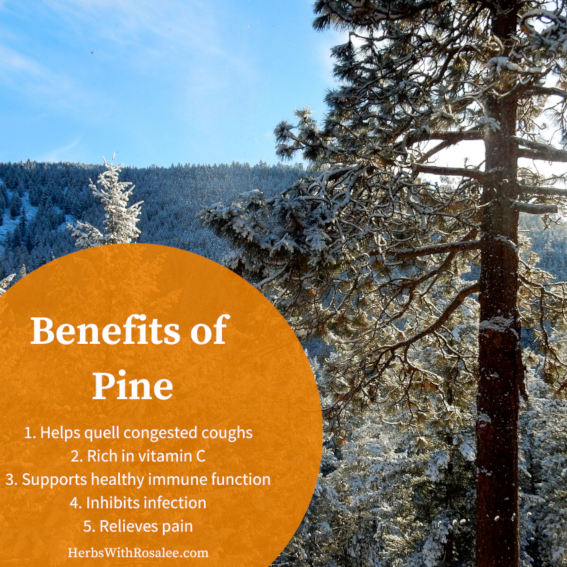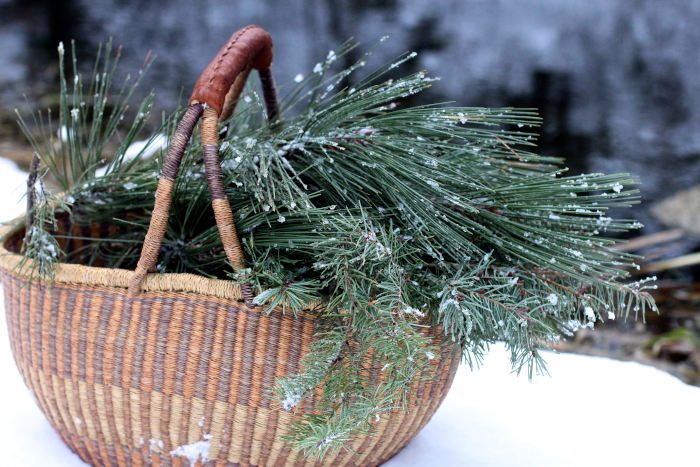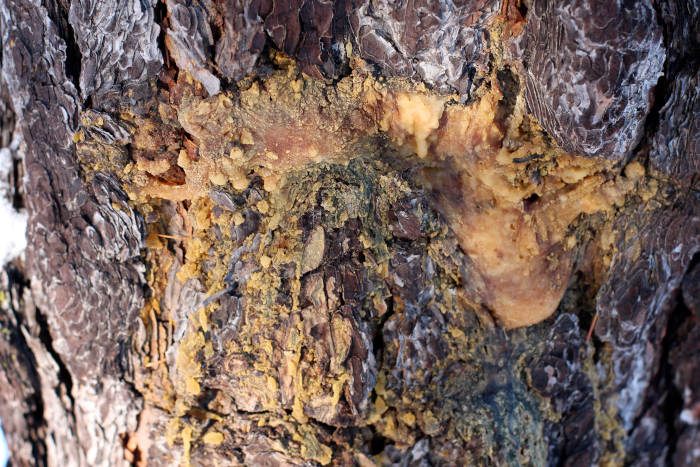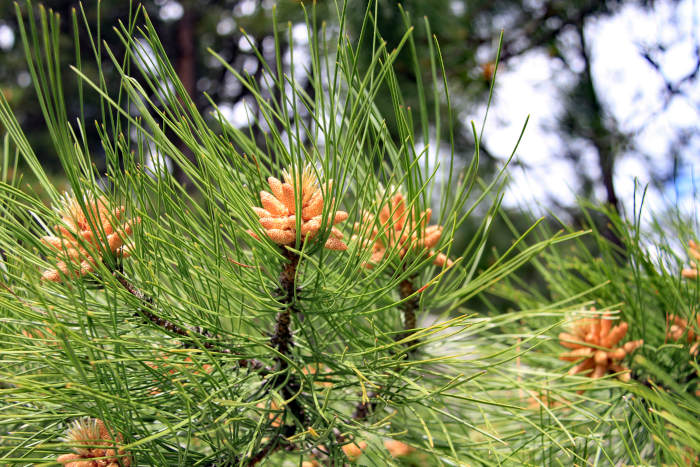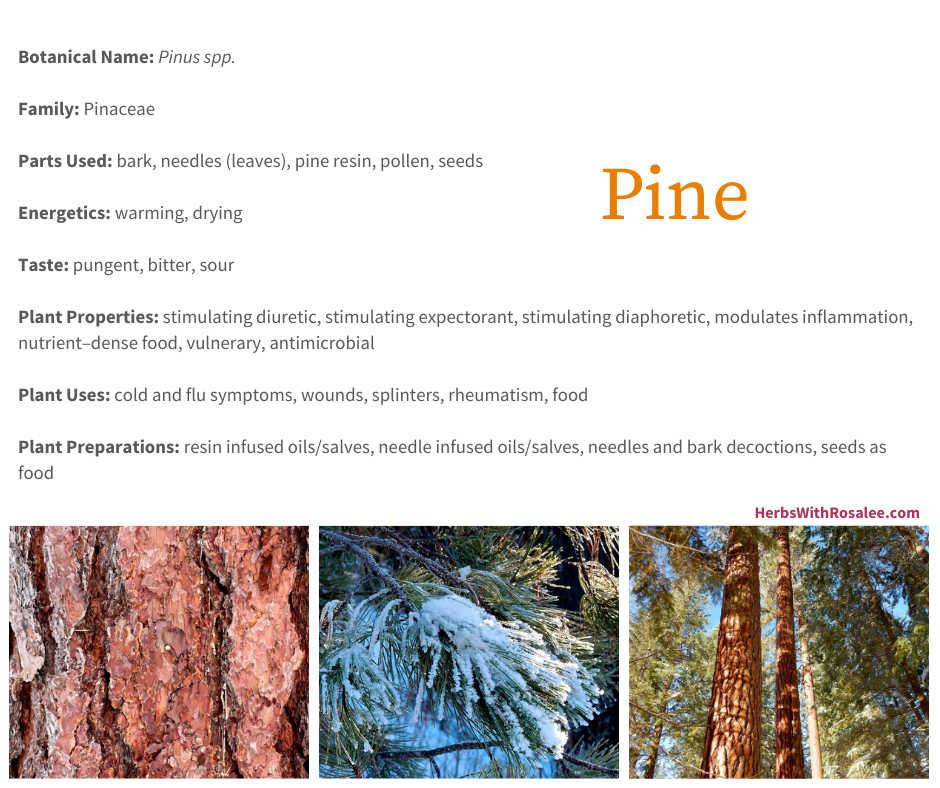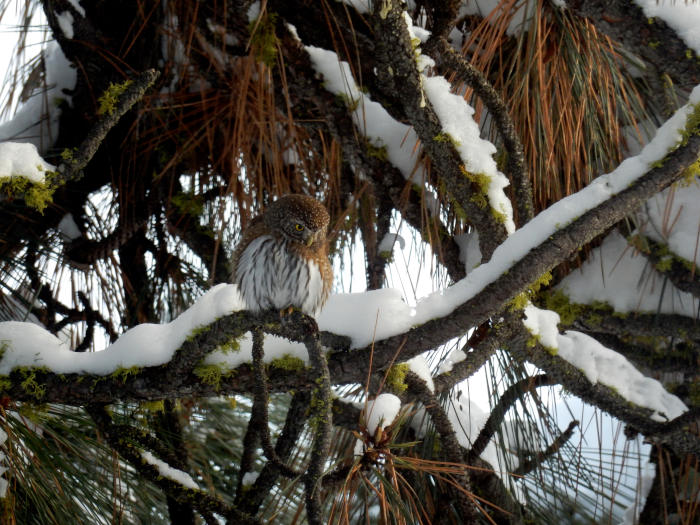Get weekly tips, recipes, and my Herbal Jumpstart e-course! Sign up for free today.

Pine Properties
Share this! |
|
The Pinus genus gives us so many pine properties beyond its timber. The needles, pine resin, bark, and pollen are all potent herbal medicines. While towering ponderosa pine trees are not often thought of as herbs, this is powerful plant medicine.
The land that my husband and I live on and caretake is filled with ponderosa pine trees and, in this episode, I share my love for these majestic plants. I also explain how to make two versions of pine needle tea. One can be potent herbal medicine. The other is more of a crowd-pleasing tea that can be enjoyed whenever you feel like sipping a bit of the forest.
After this episode, you’ll know:
► What’s a sign to rouse your inner skeptic when it comes to superfood claims?
► Are pine needles from any pine species safe for tea-making?
► Is it better to harvest young pine needles or older ones—and why?
► How to harvest pine needles sustainably (and when not to harvest)
-- TIMESTAMPS -- for Pine Properties
00:00 - Introduction to the Ponderosa pine tree (Pinus ponderosa)
03:53 - Ponderosa pine energetics
05:03 - Is Ponderosa pine safe?
05:52 - Pine needles as food and medicine
07:31 - Pine resin as medicine
08:42 - Pine pollen as food and medicine
10:07 - Pine bark as medicine
10:40 - How to identify Ponderosa pine trees
12:43 - How to make pine needle tea
14:15 - Medicinal pine needle tea recipe
15:10 - Recipe for crowd-pleasing, holiday pine needle tea
17:53 - Ponderosa Pine Fun Fact
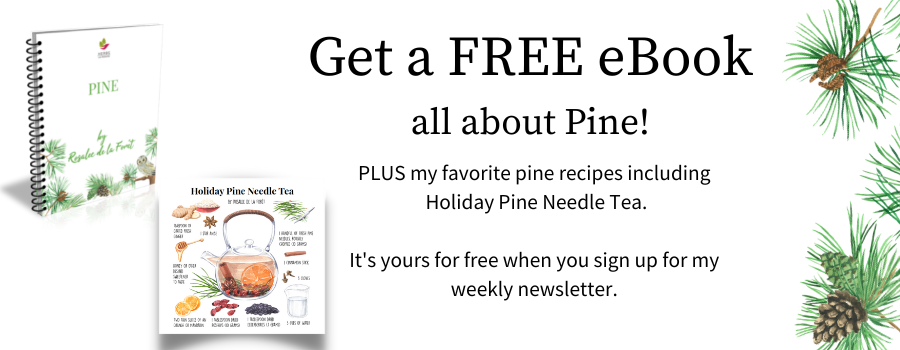
Transcript of the Pine Properties Video
I live in a beautiful ponderosa pine tree forest in Washington state. I love spending time with these huge trees and all the life they support. I also love that ponderosa pine trees offer us so much food, medicine, and other gifts. In this episode I’m going to show you how to make two types of pine needle tea. A medicinal brew and a delicious recipe sure to impress your friends and family. Also in this episode I’ll be sharing the benefits and side effects of the Ponderosa Pine Tree.
My office windows look out onto a beautiful pine tree. Many moments of my day are spent gazing at the branches and the life within it. A squirrel is a frequent visitor, gnawing pine cones, leaving a midden of pine cone scales below. I’ve seen many birds stop for a rest, including a pygmy owl last winter. This is what my dad jokingly calls cheap entertainment. Cheap, of course, in price only. The moments of peace and beauty around a pine tree are priceless.
Pine trees are conifer or evergreen trees within the Pinus genus. You probably have pine growing near you as there are at least 126 recognized species of pine trees across the globe.
Pine trees can live for hundreds or even thousands of years. One of the world’s oldest living organisms is a bristlecone pine tree (Pinus longaeva) called Methuselah who is 4,600 years old.
The land we live on and care take is filled with pine trees, from the smallest of saplings to large giants towering a hundred feet into the sky. Our home is a cabin constructed with large pine and Douglas fir logs. Chances are your home is built with pine too, as pines are one of the most commercially important trees across the globe and are frequently used in home construction.
We even rely on pine wood to keep our cabin warm. While the soft wood isn’t ideal for burning, we do use it mixed in with Douglas fir in our wood stove. It keeps us warm and is 100% cat approved.
Pine gives us many gifts beyond its timber. The needles, pine resin, bark, and pollen are potent herbal medicines. While towering pine trees are not often thought of as herbs, this is powerful plant medicine.
Pine Properties: Energetics
Ponderosa pine tree medicines are warming and aromatic. I love their scent, whether it’s their amber-like resinous qualities or the mild vanilla aromatics of their bark.
Ponderosa medicine is warming and drying. We work with this medicine to warm us up, and to help move stuck moisture like congestion in the lungs. Depending on the part you’re tasting, ponderosa pines can be pungent, bitter, or even sour.
If you’re new to the concepts of herbal energetics and understanding if a plant or a condition is hot or cold or damp or dry then I highly recommend my free Herbal Jumpstart Course.
This short video course takes you through the ins and outs of herbal energetics and, by the time you finish, you’ll have increased your herbal knowledge 10 fold.
This course is entirely free to everyone who joins my herbal newsletter community. In addition to getting the free Herbal Jumpstart Course you’ll also hear from me every Wednesday with my best herbal tips and recipes. And, this week, get my Pine Ebook as well by signing up below!

Pine Properties: Safety Considerations
If you’re looking at ponderosa pine tree information online, then you’ll see it often repeated that it isn’t safe. As someone who has been drinking pine needle tea for a long time, I disagree. I decided to chase down the source of this information.
Here’s what I found:
There’s a study showing that cattle eating large amounts of ponderosa pine needles aborted their fetuses.1 This effect hasn’t been seen in humans, or even in other animals, but it is frequently recommended that people avoid eating the needles or tea during pregnancy and breastfeeding. That seems like a fair precaution.
However, having small to moderate amounts of pine needles is going to be fine for most people.
Pine Properties: Pine Needles as Food and Medicine
Have you nibbled on a pine needle lately? It has a surprising taste! Certainly resinous with a touch of bitter, but the most potent flavor that initially bursts on the tongue is the tart/sour taste indicating high vitamin C levels. Per gram, pine needles have more vitamin C than an orange. The young needles have less than older needles, although the younger needles make a tastier tea. To get the most vitamin C from pine needles, eat them raw or infuse them into honey or cold water. Making a hot tea from pine needles does destroy some of the vitamin C, but some remains in the warm brew.
A simple pine needle tea is a delicious beverage and something that can be enjoyed anytime by a healthy person. I love sipping on pine needle tea knowing that I am tasting the forest around me. I’ll have a couple of pine needle tea recipes for you in just a bit.
There’s also several ways pine needle tea can be helpful during a cold or influenza virus.
Simmering pine needles (decoction), rather than simply steeping in hot water, pulls out more of the resinous and pungent qualities. In this form, the medicine becomes a stimulating expectorant and diaphoretic. I especially love it for thinning congested mucus in the lungs and sinuses. For best results, breathe the steam deeply as you drink. Pine needles are also soothing to a sore throat, either as a hot beverage or infused into honey.
Pine Properties: Pine Resin as Medicine
When a pine tree is injured it exudes a thick sticky and resinous substance. This pine resin forms a protective layer across the bark, helps to repel or trap boring insects, and is also antimicrobial, thus further protecting the tree from pathogens.
Pine resin offers strong medicine to us too.
Pine resin is widely used externally as a vulnerary, pain reliever, and “drawing” preparation to remove splinters or other foreign objects from the body.
Michael Moore recommends chewing a currant-sized piece of pitch to swiftly encourage “strong, fruitful expectoration and a general softening of bronchial mucus.”2
I’ve tried chewing it and I didn’t love the way it stuck to my teeth… but to each their own.
Pine resins have long been used to ease rheumatic and muscular pain, as a topical cream, topical salve, or bath herb.
A salve made from pine resin can be rubbed over the chest and back to relieve lung congestion.
Pine Properties: Pine Pollen as Food and Medicine
Pine pollen has become something of a superfood fad in recent years. It is being marketed and sold as a hormonal cure-all for both men and women. I’m a bit of a skeptic here. While I have no doubt that pine pollen offers us food and medicine, the most vocal and outrageous claims often come from people selling expensive pine pollen medicines.
I first learned about pine pollen as a nutrient-dense wild food. We harvest the pollen in the spring and add it to crepes and pancakes.
A review of pine pollen as medicine within Traditional Chinese Medicine studies found that pine pollen had a lot of potential in regards to alleviating skin conditions.3 The review stated that, “Its use as a topical agent, especially for skin diseases, was notable.”
Some years the conditions are just right to have a pine pollen storm. All you need is mature male pine cones that are filled with pollen and then a bit of wind. When this happens it looks like a thick dust storm, but it’s all pollen! Weeks after a pine pollen storm you can still find me sweeping pine pollen off of our decks and dusting it from inside the house. (On a related note, if there’s a pine pollen storm it’s a really good idea to close your windows.
Pine Properties: Pine Bark as Medicine
Pine bark, especially the inner cambium, is worked with similarly as the needles and pitch for increasing expectoration and supporting the immune system.
A decoction of the inner bark is considered to be stronger than the needles and was historically used for lung infections. The cambium was commonly eaten, sometimes as a famine food, by various First Nations peoples.
With a bit of training you can sustainably harvest the cambium, however, it’s a lot easier to work with the pine needles.
Pine Properties: Botanically Speaking
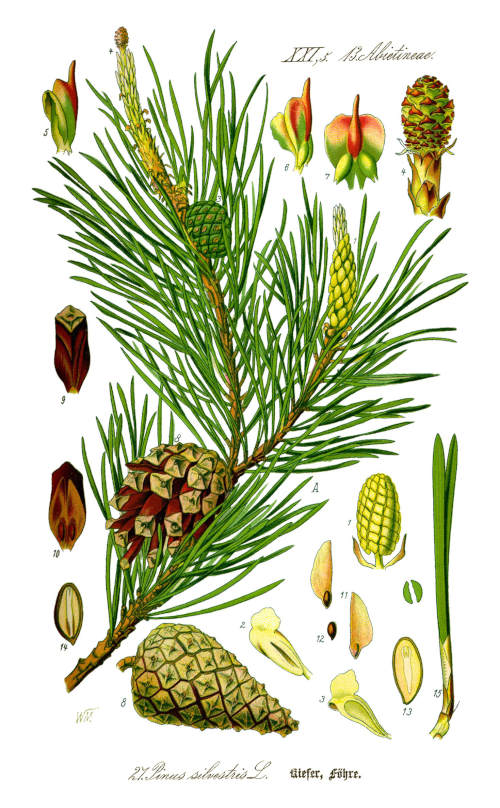
Trees in the Pinus genus can be distinguished from other conifers by their needles (leaves). Pine trees have needles bound in groups of two or more and there is a papery sheath holding them together at the bottom.
There are at least 126 recognized species of pine. To determine your local species, reference a local tree field guide.
Ponderosa pine is the most widely distributed pine species in North America.
It loves to grow in sunny locations in mountainous regions.
The needles grow from 5-10 inches long and are in bundles of three (sometimes two).
The female cones are four to six inches long. When mature, they turn upside down to release their seeds.
Bark on young trees is brown to black. Older tree bark has large scales and the bark is a more reddish or orange color. The thick bark scales protect the tree from the natural fires that occur in Ponderosa pine habitats.
You might be wondering if other pine trees, or even evergreens, can be worked with similarly to what I’ve shared about Ponderosa Pine.
In our book, Wild Remedies, we have an entire chapter about evergreen trees, including how to identify and harvest several many different species. We also share a lot of my favorite winter recipes like Evergreen Seasoning Salt, Spiced Evergreen Liqueur, Evergreen Oxymel, Evergreen Infused herbal Oil, which you can then use to make a Forest Facial Cream and lip balm.
Wild Remedies is perfect for you if you want to learn more about the plants growing near you. Included with each herbal chapter is safety information, sustainable harvest instructions and lots of fun and easy recipes like this one. You can order Wild Remedies from your favorite bookstore. Check out the back of the book to get access to your exclusive bonuses.
Pine Properties: How to Make Pine Needle Tea
To make a pine needle tea, you can harvest the needles at any time of the year. The fresh, new growth will taste better and is great to add to foods. The older needles have a higher vitamin C content.
I’m going to share how to make two different pine needle teas. One can be potent herbal medicine. The other is more of a crowd-pleasing tea that can be enjoyed whenever you’re feeling like sipping a bit of the forest.
You might be wondering if you can use any pine tree for this recipe. The answer is yes! But! Be sure to properly identify the tree you are working with. Although most Pinaceae plants are safe, avoid the potentially deadly yew (Taxus spp.), which has single, flat needles and distinctive red berries. And though it is not truly a pine, the so-called Norfolk Island pine (Araucaria heterophylla) can cause gastrointestinal upset and dermatitis.
Another thing to consider is the ethical harvest. Some pine-family trees are endangered, threatened, or under stress from drought, fire, or pine beetles. Learn about your area’s particular species and ecosystem before harvesting. When you do harvest, gather a handful of needles from different trees to avoid causing too much stress on any one tree.
How to Make a Pine Needle Tea Recipe for Medicine
For this recipe we are making a strong pine needle tea, as a simple, that will help you with common symptoms of a cold or flu like a sore throat and congested sinuses and lungs. This brew is specifically a stimulating expectorant, which means it moves stuck mucous. I wouldn’t reach for this tea unless you were experiencing a lot of congestion.
The ingredients for this tea are:
- handful of fresh pine needles, roughly chopped (10 grams)
- 2 cups of water
Place the needles and water in a small sauce pan. Turn the heat to medium high and bring to a simmer. Reduce the heat to maintain this low simmer for 20 minutes.
Strain. Add honey or another sweetener of choice, if desired. And drink warm.
Next up…
How to Make a crowd-pleasing Pine Needle Tea Recipe
I love drinking pine needle teas. It’s truly the taste of the earth I live on. In this recipe I combine other favorite winter spices to create a delicious tea that can be enjoyed as an after-meal digestive tea or as part of a winter celebration.
The ingredients for this recipe are…
- handful of fresh pine needles, roughly chopped (10 grams)
- 1 tablespoon dried elderberries (7 grams)
- 1 tablespoon dried rosehips (10 grams)
- two thin slices of an orange or mandarin
- 1 cinnamon stick
- 3 cloves
- teaspoon of grated fresh ginger
- 1 star anise pod
- 3 cups of water
- honey or other desired sweetener to taste
Place all the herbs, spices, and water into a small sauce pan. Turn the heat to medium high and bring to a simmer. Reduce the heat to maintain this low simmer for 10 minutes, while covered.
Strain. Add honey or another sweetener of choice, if desired. And drink warm.
I love giving you quick tips on herbal medicine making. That’s because I believe that when you work directly with the plants to make the remedies that you and your family depend on, you are creating a lifetime of skills and knowledge that go way beyond simply listening to me. But to really succeed with herbal medicine you need more than a few quick tips.
That’s why I co-teach a four-season online course that shows you exactly how to make a variety of potent herbal medicines, from start to finish. If you want to be the person that you and your family and friends rely on for effective herbal medicines, then check out our course, Rooted Medicine Circle. This course only enrolls in January, so check it out soon and get on the waitlist for future openings.
Ponderosa Pine Fun Fact
Pines are a towering gift of this earth whether they are providing us shelter, warmth, food, or medicine. Even pine pollen storms are a bountiful source of nutrients for the grounds they fall on. Each year, a massive quantity of pollen falls to the ground and enriches the soil, feeding soil microbes and small creatures like worms with all the nutrition it embodies.4 I love the image of these huge towering trees circling around to feed the smallest microbes growing at their feet.
If you enjoyed this video on ponderosa pine trees and you value trusted herbal information, then I hope you’ll stick around! The best way to get started is to sign up for my weekly newsletter below so you can be the first to get my best herbal insights and recipes. And this week, also get a whole Ebook about Pine Properties!

Citations for Pine Properties
Click to show/hide.

Rosalee is an herbalist and author of the bestselling book Alchemy of Herbs: Transform Everyday Ingredients Into Foods & Remedies That Healand co-author of the bestselling book Wild Remedies: How to Forage Healing Foods and Craft Your Own Herbal Medicine. She's a registered herbalist with the American Herbalist Guild and has taught thousands of students through her online courses. Read about how Rosalee went from having a terminal illness to being a bestselling author in her full story here.
